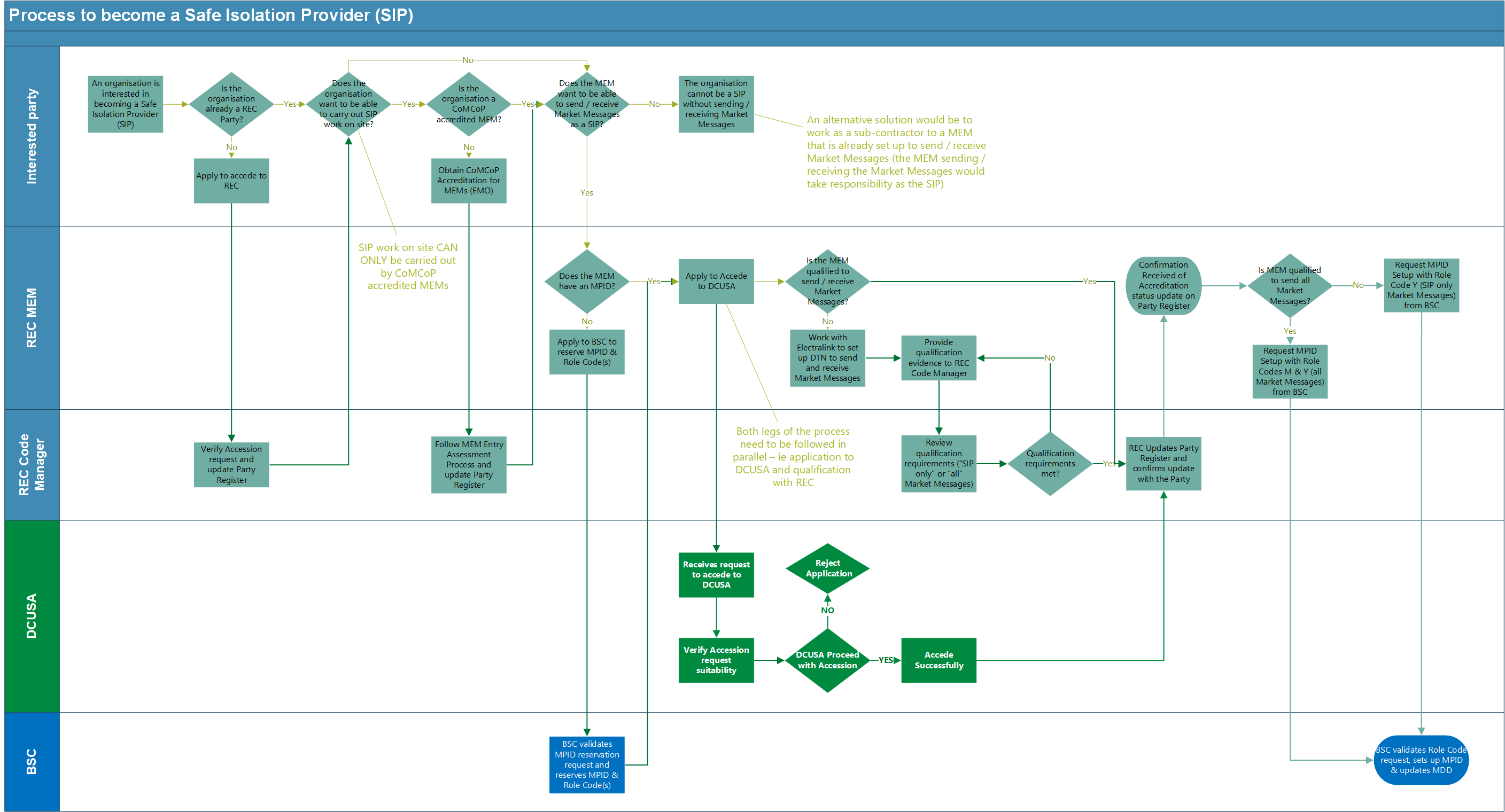Safe Isolation Provider (SIP) - Metering

Safe Isolation Provider (SIP)
Safe Isolation Provider (SIP) is an additional role available to existing accredited Meter Operator Agents (MOAs) to allow them to accept instructions to undertake a limited set of activities at the request of the premise owners without the need to use the Registered Suppliers’ MOAs.
In order to perform physical work associated with the SIP role, such as de-energising and re-energising meter points, you need to be a Electricity Metering Operative (EMO) accredited under the Consolidated Meter Code of Practice (CoMCoP). The scope of CoMCoP EMO work can be found in the CoMCoP document. You must be able to perform the full scope of this work, including meter installations, exchanges, and removals in order to obtain the CoMCoP accreditation.
The SIP role was introduced in June 2023 as a result of R0021 / R0101 Change Proposals implementation. The contractual guidance, business process maps, communication requirements and information about assurance processes for the SIP role can be found in the R0101 Solution Overview document.
The list of the companies that are registered as SIPs can be found in the Retail Energy Code (REC) Party Register (CoMCoP - Elec MOA&SIP tab) on the REC Portal.
| Contents |
Scope of the SIP’s Permitted Work
The scope of work that a SIP is authorised to carry out is
deliberately limited and is set out in Section 2H of Distribution Code
Use of System Agreement (DCUSA).
‘Safe Isolation Works’ means,
in respect of an Entry/Exit Point, works by a SIP Party to:
- De-energise that Entry/Exit Point;
- (If reasonably necessary) adjust the terminals of the meter and associated equipment and re-make the connection to them to make safe and remedy any disturbance of the connection that may have occurred;
- If required, terminate/replace the customer tails on the Electricity Supplier's meter (provided that such tails must have been provided and tested by the SIP Party or the customer's electrical engineer); and
- Re-energise that Entry/Exit Point.
The SIP must not undertake any other work related to the Supply Point, or otherwise interfere with the Registered Supplier’s metering equipment.
Becoming a SIP
The following steps are required to apply to become a SIP, depending on the organisation and the SIP activities that they want to carry out::
| Organisation… | - wants to carry out SIP work on site and send relevant Market Messages | - wants to send relevant Market Messages only (and will use a third party to carry out SIP work on site) | - wants to carry out SIP work on site ONLY (and will use a third party to send relevant Market Messages) |
| - is NOT a REC Party | Steps 1, 2, 3, 4, 5 & 6 | Steps 1, 3, 4, 5 & 6 | Steps 1 & 2 |
| - is a REC Party with CoMCoP Accreditation & NOT Qualified to Send Market Messages | Steps 3*, 4, 5 & 6 (*Step 3 only required if the organisation doesn’t already have an MPID) | Steps 3*, 4, 5 & 6 (*Step 3 only required if the organisation doesn’t already have an MPID) | No further steps required |
| - is a REC Party Qualified to Send Market Messages & NOT CoMCoP Accredited | Steps 2, 5 & 6 | Steps 5 & 6 | Step 2 |
| - is a REC Party with CoMCoP Accreditation & Qualified to Send Market Messages | Steps 5 & 6 | Steps 5 & 6 | No further steps required |
1. Accede to the REC as a Metering Equipment Manager or an Electricity Metering Operative
The first step in the application process to accede to the REC as a Metering Equipment Manager is to create a REC Portal account. The REC Portal user guide gives detailed instructions on how to set up an account.
Once the REC Portal account is set up, from the Party Operations area of the Portal, select "Applications", to access the online Application form to apply to become a REC Party.
When the initial application is submitted, the Code Manager will send a REC Welcome Pack to the applicant. They will also be appointed an Operational Account Manager (OAM) and Lead Assessor who will be on hand to answer any questions and provide support throughout the application.
Once the initial application has been validated, a REC Accession Agreement will be sent to the applicant by the Operational Account Manager.
2. Obtain accreditation to work as an Electricity Metering Operative with CoMCoP
To enable an EMO to carry out work on Metering Equipment, they will need Consolidated Metering Code of Practice (CoMCoP) Accreditation. To achieve this, they will need to complete the Entry Assessment process.
The Entry Assessment process is designed to provide assurance that new entrant’s market training, guidance and processes are fit for purpose. Each applicant must complete Entry Assessment to demonstrate that it is able to comply with its obligations, set out in the Code, and become accredited.
For a detailed overview of the REC Entry Assessment process please refer to the Market Entry Wiki article.
3. Set up a Market Participant Identifier (MPID)
An MPID is a four-digit code that identifies a Party in the electricity market.
For a brand new Party with no existing Role Code, the Party should contact the BSC’s Market Domain Data (MDD) Coordination Team (mddc@elexon.co.uk) to request/reserve/agree a unique MPID.
There is no setup or ongoing cost in registering a new MPID.
4. Demonstrate the ability to successfully send and receive Market Messages through the Data Transfer Network (DTN)
The DTN transfers industry created Market Messages between industry parties.
The SIP will need to demonstrate the ability to send and receive communications to industry Parties using Market Messages (Dataflows) over the DTN.
For the list of SIP-related Market Messages please refer to the Solution Overview document.
5. Accede to DCUSA
A REC Accredited SIP must accede to DCUSA in order to set up the necessary legal permissions to undertake SIP works, by completing the DCUSA accession form that can be found on the DCUSA website.
Once submitted, the DCUSA Secretariat will review the accession form to ensure that all requirements have been met. Once that is completed, DCUSA will notify the REC Code Manager to update the REC Party Register to reflect the SIP accession.
6. Apply to BSC for a SIP Role Code (“Y”)
Once the SIP has acceded to DCUSA and demonstrated that they are able to successfully send and receive the required Market Messages, they will need to apply to the BSC for Role Code “Y” (SIP) to be applied in the next update to Market Domain Data. A comprehensive overview of the Market Domain Data process is available on the BSC website.
- To register the new MPID & SIP Role Code, Parties who do not currently have a live MPID need to complete:
- Parties that already exist in MDD with an active MPID need to complete the following:
These requests follow the MDD Fast Track CR Deadline process. More details and the monthly schedule are available using this link. The lead time for assignment of the code is approximately one month following the SIP’s application.
Further support is available through the BSC Service Desk or by contacting the MDD Co-ordinator (MDD Co-ordinator at mddc@elexon.co.uk).
Once the MPID/Role Code has been updated in the MDD, the process is complete.
Frequently Asked Questions
See more: Safe Isolation Provider Frequently Asked Questions
Can I enter into a SIP contract with a premise owner if I am not able to send Market Messages using the DTN, using my MPID?
No. Only SIPs who are capable of sending Market Messages via the DTN, with the Role Code “Y”, can enter into contracts with Premise owners to undertake work at their instruction, to facilitate the installation of Isolators or to allow the installation of other equipment in both domestic and non-domestic premises - such as an Electric Vehicle Charging Points, where the SIP will De-energise the supply point and then re-energise it again on completion of this ancillary work.
I am a qualified EMO whose Market Messages are sent on my behalf by another MOA. Can I apply to become a SIP?
To become a SIP you would need to be able to send Market Messages via the DTN using your own MPID. Another Party with their own MPID cannot use this to send Market Messages on your behalf.
Who can SIPs work for?
SIPs can agree contracts directly with Premise Owners – such as Local Authorities, Social Housing Associations, Private Landlords, or individual owner occupiers.
The Premise Owner can enter a contract with the Safe Isolation Provider to undertake the relevant work. The Premise owner must ensure the tenant is aware that this work is being undertaken and by whom.
How does a Safe Isolation Provider know the person requesting the work is the Premise Owner?
The SIP will ask the Contracting Party for assurance that they are the Premise Owner and are authorised to ask for the work to be undertaken.
How will I know the installer is a Safe Isolation Provider?
You can check if a Metering Equipment Manager (MEM) is a SIP within the REC Party Register or by checking with our Service Desk Team. You can contact us at enquiries@recmanager.co.uk or by clicking on the webchat icon.
Does the SIP need the consent of the Supplier before they can work on the Supplier’s asset?
No, the SIP is authorised to work on the Supplier’s equipment, to the extent permitted by the accession terms within DCUSA. The scope of the work is intentionally very narrow and is to provide a service to premise owners to enable them to request isolation work on site through a single party, irrespective of which Suppliers provide electricity to the site. The expectation is that this will help reduce the instances where this work is done without the necessary authority.
Does the SIP need the consent of the distributor before they can work on the DNO asset?
No, the SIP is authorised to work on the Distributor’s equipment, to the extent permitted by the accession terms within DCUSA.
What type of properties and meters can a SIP work on?
The solution only applies to Whole Current Meters, whether the customer is domestic or non-domestic. The proposed solution doesn’t stipulate what type of property a SIP can work on; however, the SIP may not work on a meter for which they are not qualified under their REC EMO accreditation.
What work can’t a SIP undertake?
When the SIP attends the premises under a contract with the Premise Owner, they cannot perform any other metering-related activity that would be reserved to the supplier and their MOA under their contractual relationship. For example, they cannot move or exchange a meter.
Further Reading
- Implementation of R0021 / R0101 in June 2023
- R0021 "Allowing REC accredited MEMs to de-energise and re-energise supply points independent of the Supplier"
- R0101 "Revision of the Implementation Date and approved solution for R0021"
- SIP Party Accession - DCUSA
- R0101 - Safe Isolation Provider Solution Overview
- Phased Implementation Approach
- Safe Isolation Provider Frequently Asked Questions



